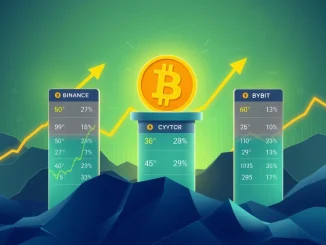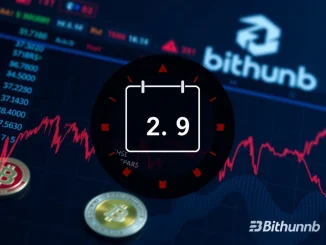
Breaking news for ZKsync (ZK) holders! Major South Korean crypto exchanges, Bithumb and Coinone, have just announced a significant update that could impact your investments. In a move that has sent ripples through the crypto community, both exchanges have designated ZKsync (ZK) as a ‘closely monitored asset.’ This decision, stemming from the Digital Asset eXchange Alliance (DAXA), signals a heightened level of scrutiny for the Layer-2 scaling solution.
Why is ZKsync Under Scrutiny by Crypto Exchanges?
The designation of ZKsync as a closely monitored asset isn’t a decision taken lightly. DAXA, a consultative group comprising South Korea’s leading crypto exchanges, plays a crucial role in maintaining market integrity and investor protection. When DAXA flags an asset, it’s a signal that potential risks or concerns warrant increased attention. But what exactly does ‘closely monitored’ mean, and why should you, as a crypto enthusiast or investor, care?
Let’s break down the key aspects:
- DAXA’s Role: The Digital Asset eXchange Alliance (DAXA) acts as a self-regulatory body in the South Korean crypto space. Its primary objective is to establish guidelines and monitor digital assets to safeguard investors and prevent illicit activities. Think of them as the watchdogs of the Korean crypto market.
- ‘Closely Monitored Asset’ Status: This designation isn’t a delisting announcement, but it’s a step before that. It indicates that DAXA and the exchanges have identified potential risks associated with ZKsync that require careful observation. These risks could range from price volatility and low liquidity to concerns about the project’s development or regulatory compliance.
- Bithumb and Coinone’s Action: By officially announcing this designation on their platforms, Bithumb and Coinone are proactively informing their users about the increased risk level associated with trading ZKsync. This transparency is crucial for investors to make informed decisions.

What are the Potential Implications for ZKsync and Investors?
The immediate question on everyone’s mind is: what does this mean for ZKsync and those holding or considering investing in it? While the situation is still developing, here are some potential implications to consider:
- Increased Volatility: News of being designated as a closely monitored asset can trigger market uncertainty and fear. This could lead to increased price volatility for ZKsync in the short term. Traders might react by selling off their holdings, contributing to downward pressure.
- Decreased Liquidity: If exchanges or market makers become hesitant due to the increased monitoring, liquidity for ZKsync trading pairs might decrease. Lower liquidity can make it harder to execute trades at desired prices and amplify price swings.
- Potential Delisting Risk: While not an immediate threat, being placed under close monitoring is often seen as a precursor to potential delisting. If the concerns raised by DAXA are not addressed or if new issues emerge, crypto exchanges might eventually decide to delist ZKsync to protect their users from further risks.
- Impact on Project Reputation: This news can negatively impact the reputation of the ZKsync project, even if temporarily. Investor confidence might waver, and future adoption or partnerships could be affected.
Is South Korea Tightening the Reins on Crypto Exchanges and Assets?
This development with ZKsync occurs within a broader context of evolving crypto regulations in South Korea. The country has been at the forefront of crypto adoption and innovation, but also increasingly focused on regulatory oversight to manage risks and protect consumers.
South Korea has demonstrated a proactive approach to regulating the crypto space, aiming to strike a balance between fostering innovation and ensuring market stability. Recent regulatory trends include:
- Enhanced KYC/AML Requirements: Korean exchanges are subject to stringent Know Your Customer (KYC) and Anti-Money Laundering (AML) regulations to prevent illicit financial flows through digital assets.
- Increased Scrutiny of Altcoins: Regulators and DAXA are paying closer attention to altcoins, especially those with lower market capitalization or perceived higher risk profiles, as evidenced by the ZKsync monitoring.
- Focus on Investor Protection: The overarching theme of South Korea‘s crypto regulation is investor protection. Actions like the ZKsync monitoring demonstrate a commitment to alerting investors to potential risks associated with certain assets.
Actionable Insights for ZKsync Holders
If you are currently holding ZKsync tokens, what should you do? Here are some actionable insights:
- Stay Informed: Keep a close watch on official announcements from Bithumb, Coinone, DAXA, and the ZKsync project itself. Understanding the specific reasons behind the ‘closely monitored’ status is crucial.
- Assess Your Risk Tolerance: Evaluate your personal risk tolerance. If you are risk-averse, you might consider reducing your exposure to ZKsync, especially given the increased uncertainty.
- Diversify Your Portfolio: This situation underscores the importance of diversification in crypto investments. Avoid putting all your eggs in one basket. Distribute your investments across different assets to mitigate risks.
- Monitor Market Movements: Pay close attention to ZKsync‘s price action and trading volume on Korean exchanges and globally. Significant price drops or liquidity issues could be warning signs.
- Consider Staking/Yield Farming Risks: If you are participating in staking or yield farming with ZKsync, be aware that these activities might also carry increased risks if the project faces further challenges.
The Road Ahead for ZKsync and Crypto Exchanges
The designation of ZKsync as a closely monitored asset by crypto exchanges in South Korea is a noteworthy development. It serves as a stark reminder of the dynamic and sometimes unpredictable nature of the crypto market. While it’s not a definitive negative outcome for ZKsync, it’s a clear signal that the project is under increased scrutiny.
For investors, this situation highlights the critical need for due diligence, risk management, and staying informed about regulatory developments. The crypto landscape is constantly evolving, and proactive monitoring of your investments and the regulatory environment is paramount for navigating its complexities successfully. The future trajectory of ZKsync will depend on how the project addresses the concerns raised and how DAXA and crypto exchanges in South Korea respond in the coming weeks and months. Stay tuned for further updates as this story unfolds.



